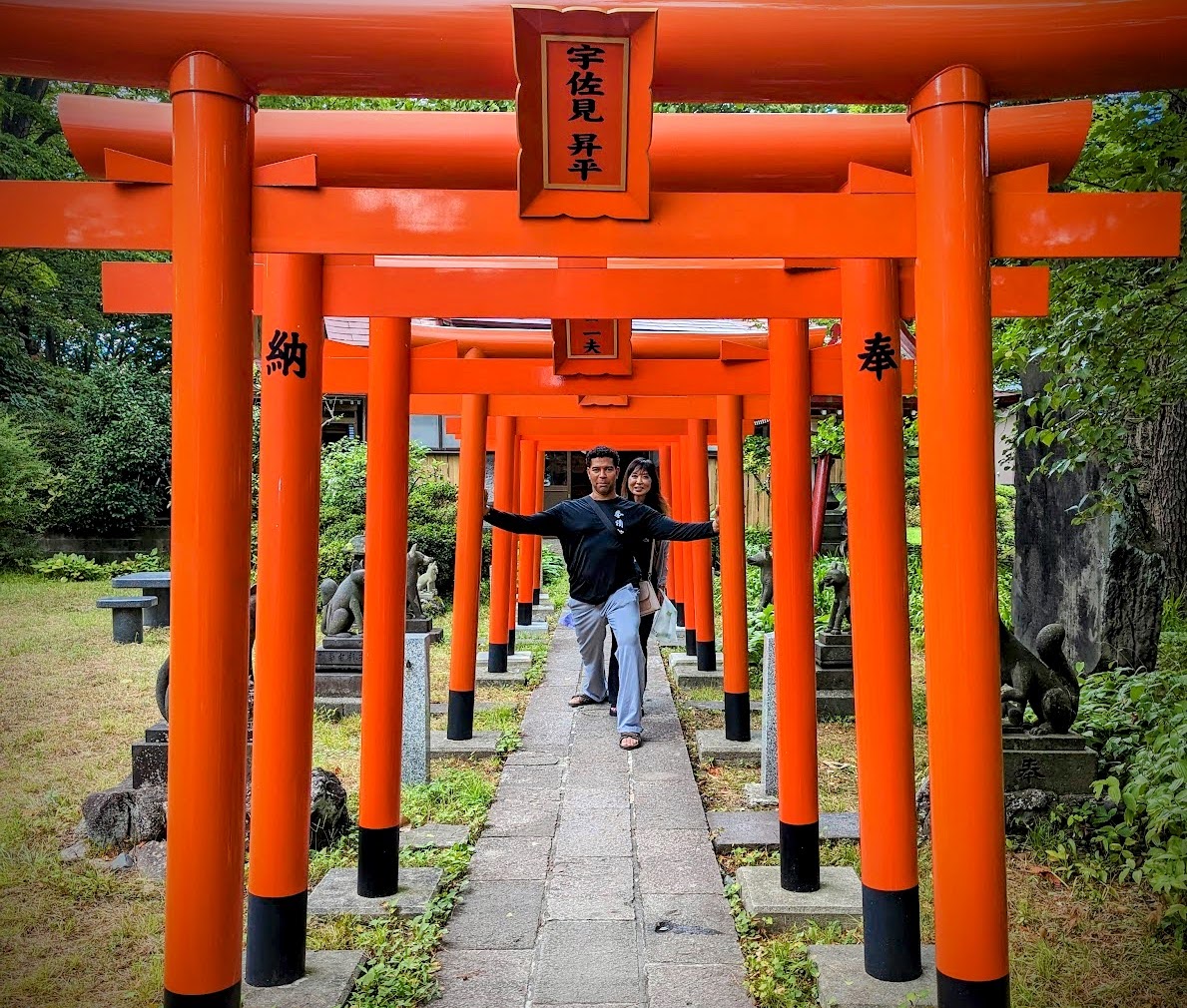Preparing for Your Summer Budo Gasshuku in Japan:
A Guide for Participants
All Gojuryu Network (www.gojuryu.network) & SKSV (Gojuryu.net) cross-post
By Johnpaul Williams – August 31, 2023
Many Sensei and instructors have undoubtedly prepared their students for summer budo (Karatedō, judo, kendo, etc.) Gasshuku, but sometimes, written instructions can be invaluable. Some portions of this memo may be familiar to those who have access to the draft copy of Volume 2 of the “Gōjūryū Karatedō Desk Reference.” We’ve long contemplated how best to inform and prepare athletes attending summer training events in Japan. Regardless of the organization or style they belong to, mental preparation is just as crucial as physical readiness. It’s important for attendees to understand that “The Japan training expedition is not a vacation.” While it’s impossible to provide a comprehensive guide to this life-changing experience, we’ll offer a general outline that should benefit both first-timers and repeat participants. This guide is intended for all participants, regardless of their grade, position, or status, because sometimes, those who think it doesn’t pertain to them are the ones who may need it most.
Understanding the Purpose. First and foremost, it’s crucial to grasp the purpose of your journey to Japan for the summer budo Gasshuku. This is not a vacation or leisure trip. You’re embarking on an intensive training experience that demands dedication, discipline, and mental fortitude. Be prepared to push your physical and mental limits, as this expedition is about personal growth, skill development, and cultural immersion.
Mental Preparation
- Leave Expectations Behind: Approach this experience with an open mind and leave behind any preconceived notions. Every aspect of training in Japan may differ from what you’re used to, so be receptive to new techniques, methods, and cultural customs.
- Embrace Humility: Regardless of your rank or status back home, understand that in Japan, you’re a student. Be respectful, humble, and eager to learn. The instructors and senior practitioners in Japan have a wealth of knowledge to share.
- Cultural Awareness: Familiarize yourself with Japanese customs and etiquette. This includes bowing, removing your shoes before entering certain areas, and respecting personal space. Learning a few basic Japanese phrases can also be helpful.
Physical Preparation
- Conditioning: Ensure you’re in good physical condition before departing. This includes cardiovascular fitness, strength training, and flexibility. The training in Japan can be intense, so being physically prepared is essential.
- Technique Review: Brush up on your fundamental techniques and kata. You’ll likely receive detailed instruction and corrections during your stay, but having a solid foundation will be beneficial.
- Injury Prevention: Take precautions to prevent injuries. This includes proper warm-ups, cooldowns, stretching, and knowing your physical limits. Don’t hesitate to communicate any injuries or discomfort to your instructors.
Logistical Preparation
- Documentation: Ensure you have all necessary travel documents, including your passport, visa (if required), and any confirmation emails or letters from the event organizers.
- Accommodations: Know the details of your accommodations, including check-in/check-out times and any specific rules or guidelines set by the venue or organizers.
- Packing: Pack light but efficiently. You’ll likely have limited space, so prioritize essential training gear, clothing, and personal items. Don’t forget any prescription medications or special dietary needs.
Attitude and Mindset
- Respect and Courtesy: Show respect to everyone you encounter, from fellow participants to instructors and locals. Courtesy and gratitude go a long way in building positive relationships.
- Adaptability: Be adaptable and flexible in your approach to training and daily life in Japan. Challenges may arise, but maintaining a positive attitude will serve you well.
- Focus and Dedication: Stay focused on your training goals and commit to giving your best effort in every session. Dedication and perseverance will help you make the most of this experience.
- Reflect and Learn: After each training session, take time to reflect on what you’ve learned and experienced. Keep a journal if possible, noting techniques, corrections, and personal insights.
Managing the Heat and Hydration During Summer Training in Japan. When embarking on summer training in Japan, it’s crucial to be well-prepared for the heat and humidity that can be quite challenging, even for individuals accustomed to warm weather. Here are some essential tips to help you stay cool and properly hydrated during your training:
Understanding the Impact of Heat and Humidity
- Increased Hydration Needs: The combination of high temperatures and humidity can significantly increase your body’s need for hydration. While a typical person may require around 2 liters of water per day, someone training in Japan might need up to 4 liters daily to stay adequately hydrated.
- Heat and Humidity Synergy: The presence of humidity can make the heat feel even more oppressive. It’s important to account for this added effect when planning your hydration strategy.
Stay Hydrated
- Bring a Quality Water Bottle: Invest in a high-quality water bottle with a convenient carrying strap. Having your own bottle ensures easy access to water throughout the day.
- Consistent Hydration: Make a conscious effort to drink water consistently throughout the day, even if you don’t feel thirsty. Waiting until you’re thirsty may indicate you’re already dehydrated.
- Electrolyte Balance: Along with water, consider replenishing essential electrolytes lost through sweating. You can drink electrolyte-rich beverages or consume foods like bananas, oranges, and salty snacks.
Learn from Past Experiences
- Omagari Training Camp Experience: The Omagari training camp in 2023 serves as a reminder of the seriousness of dehydration and heat-related issues. Approximately 20 individuals faced these challenges over seven days. To avoid such situations, prioritize your hydration.
Final Thoughts. When training in Japan’s summer heat and humidity, proper hydration becomes paramount. Understanding the increased water requirements, consistently drinking water throughout the day, and paying attention to your body’s signals are essential steps to prevent dehydration and heat-related issues. By staying vigilant about your hydration needs, you’ll be better equipped to fully immerse yourself in your training and enjoy your experience in Japan
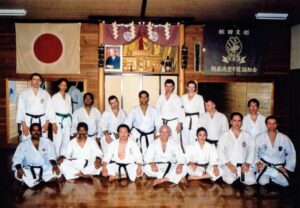
Seiwakai 2003 group in Omagari Daisen Japan
Balancing Training and Tourism During Your Trip. When you embark on a journey to participate in a ‘gasshuku’ (training camp) or ‘shiai and taikai’ (competition and convention) in Japan, it’s important to strike a balance between your training commitments and the desire to explore the country. Here are some key considerations to help you make the most of your experience:
Prioritize Your Training Commitments
- Understand the Purpose: Remember that the primary purpose of your trip is to train and participate in martial arts activities. This aligns with the essence of a gasshuku, which emphasizes intense training and camaraderie.
- Preplanned Activities: Your schedule will likely be filled with preplanned activities such as kihon (basics), kata (forms), and kumite (sparring). These sessions are integral to your growth as a martial artist, so prioritize them.
- Evening Routine: In the evenings, focus on personal care, including muscle recovery, proper nutrition, hydration, and rest. This ensures you’re in optimal condition for training.
Balancing with Tourism
- Additional Days: If you’re eager to explore Japan as a tourist, consider extending your stay. Arrive a few days before or stay a few days after your training or competition to indulge in sightseeing and cultural experiences.
- Group Activities: Explore the possibility of organizing group outings or excursions with fellow participants during free time. This way, you can enjoy some tourist activities while bonding with your peers.
- Manage Expectations: Recognize that during the main training or competition days, your time will be primarily dedicated to martial arts. Be prepared to make the most of any available free time.
- Plan Ahead: If there are specific tourist attractions or experiences you’re keen on, plan them in advance and try to fit them into your schedule if feasible.
Respect the Essence of the Trip. In summary, while it’s natural to want to experience Japan as a tourist, it’s essential to respect the essence of your trip. Embrace the rigorous training and camaraderie that come with a gasshuku or martial arts event. If you’re determined to explore Japan beyond the dojo, consider extending your stay to fully enjoy the country’s rich culture and attractions. Balancing training and tourism can lead to a rewarding and well-rounded experience.

Budget friendly hotel in Osaka with huge bathrooms
Navigating Hotel Choices in Japan. Selecting the right hotel in Japan is essential to ensure a comfortable stay during your martial arts journey. Here are some insights to help you make informed choices:
- Budget-Friendly Options: Japan offers a range of accommodations to suit various budgets. While budget-friendly options are available, it’s important to manage expectations. Some inexpensive lodgings may have smaller rooms or shared facilities. Prioritize what’s most important to you when choosing.
- Traditional Ryokans: Staying in a ryokan, a traditional Japanese inn, can be a unique and comfortable experience. Ryokans typically feature tatami-matted rooms with futon beds and traditional Japanese baths. While not always budget-friendly, they offer an authentic cultural experience.
- Room Size: Japanese hotel rooms are generally smaller than those in many Western countries. If space is a concern and / or you are a larger framed individual, consider booking slightly more expensive rooms, which may offer additional square footage.
- Bathroom Facilities: Pay attention to bathroom descriptions when booking. While modern hotels have Western-style bathrooms, some budget or traditional accommodations may have shared facilities. Check whether the hotel provides essential toiletries.
- Guest Reviews: Reading guest reviews can provide valuable insights into the quality of accommodations. Look for reviews from travelers with similar expectations to get a clearer picture of what to expect.
- Room Amenities: Consider your specific needs. If you prefer a bed over a traditional futon, make this request when booking. Many hotels now offer a mix of Western and Japanese-style rooms. To this day, my most comfortable lodging ever was at a Ryokan having a large room with no bed and only straw mat tatami on the floor with futon pads and pillows, 2 large closets along one wall and a shower where the toilet and sink were all in one exceptionally large and contained unit. This space cost me a whopping ¥6500 yen per night, about $50.00 USD at that time.
- Shower and Toilet Accessibility: For Western travelers, the style and accessibility of the bathroom can vary. If you require specific features or accessibility, communicate your needs with the hotel in advance.
- Booking Platforms: Use reputable booking platforms that provide detailed information about hotels and offer transparent reviews. This can help you make informed decisions.
- Location: Remember that your martial arts journey in Japan is about training, camaraderie, and personal growth. Your choice of accommodation should complement your experience and provide a comfortable base for your activities. By carefully considering your priorities and expectations, you can select a hotel that suits your needs and ensures an enjoyable stay. Consider the location in relation to your training venue and preferred activities. Hotels closer to your training facility may be convenient, but you may also want to explore other attractions in Japan.
- Price vs. Comfort: While budget considerations are important, prioritize your comfort. Paying a bit more for a more comfortable stay can enhance your overall experience.
The most uncomfortable lodging ever was at a hotel in Yokohama branded as a western style hotel with American amenities. I paid ¥9500 yen, about $82.00 USD per night at the time, for the facility in 2022. The tiny bathroom featured a toilet whose seat was a mere 25 cm from the opposing wall making “having a seat” impossible and forcing even a Japanese height individual to go in sideways. The “western style” shower was a 1-meter by 1-meter square box with a curtain and shower-head set 180 cm (5′ 10″) from the floor, clearly too low for the use of many westerners.
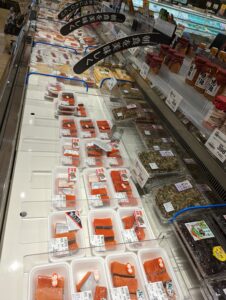
Inexpensive fresh sashimi at Japanese supermarkets
The difference in hotel amenities can be vast. Choose your dwelling amenities carefully and take advantage of genuine reviews, while watching closely for clever camera angles or unknown names. You often get what you pay for and sometimes you can get much more or much less than you expect.
Navigating Supermarkets in Japan for Affordable Dining: In the Akita area we are fortunate to have the “Granmart” supermarket. A grocery store chain popular in the region.
When training or competing in Japan, finding affordable and delicious dining options can be a rewarding experience. Here are some tips to help you make the most of Japanese supermarkets: Japanese supermarkets, like the popular “Granmart,” offer a wide range of fresh foods, baked goods, and ready-to-eat meals. These are not only convenient but also budget-friendly options.
Ready-to-Eat Meals: Supermarkets in Japan often have sections dedicated to ready-to-eat Japanese and international meals. These are not only delicious but also cost-effective. You can find a variety of options, from sushi to bento boxes. Keep an eye out for Reduced Prices on fresh goods. Supermarkets typically reduce prices during the evening to clear their inventory. Arriving early can increase your chances of finding specific items before they sell out at the discounted rates. Supermarkets can serve as your primary dining facility or take-out food provider. You can enjoy fresh and affordable meals on a budget without the need for formal dining. Japanese supermarkets provide an excellent opportunity to Explore Japanese Cuisine. You can try traditional dishes and discover new flavors at a reasonable cost. If you have access to kitchen facilities, take advantage of the fresh ingredients available at supermarkets to prepare your meals. Food Preparation can be a fun and cost-effective way to enjoy Japanese cuisine. Different regions in Japan have their own Local Specialties and local foods. Be sure to explore and try these unique offerings during your stay. Supermarkets offer Convenience and Savings for travelers. You can stock up on snacks, drinks, and essentials for your training or competition days.
Once you arrive in your training location, take some time to Exploring upon your arrival the nearby supermarkets. Note their hours of operation and the timing of price reductions for fresh items. While some supermarkets may have English signage or labels, it’s helpful to learn basic food-related Japanese phrases to navigate the store and ask questions and alleviate any Language Barrier. Dining in Japanese supermarkets is not only cost-effective but also a Cultural Experience. You’ll have the opportunity to observe locals and immerse yourself in daily life.
By exploring Japanese supermarkets and taking advantage of their affordable dining options, you can enhance your martial arts journey in Japan while staying within your budget. Enjoy the variety of flavors and convenience these establishments offer during your training or competition trip.

Taping feet before training in Japan
Caring for Your Feet During Training in Japan – “To tape is your escape!” Taking care of your feet is crucial during martial arts training in Japan, where the training floors can be sticky due to humidity. Here are some tips to ensure your feet stay comfortable and healthy:
- Taping Your Feet: Consider bringing physical therapy tape with you. Taping your feet can provide extra support and prevent skin tears caused by sticky training floors. It’s a good idea to have tape on hand for preventative maintenance.
- Prevent Skin Tears: Training floors in dojos and Budokans are known for their stickiness due to humidity. If your skin is not accustomed to this, it can lead to painful tears on your toes and the soles of your feet. Taking precautions and caring for your skin is essential.
- Choosing the Right Footwear: Bring comfortable sandals, sneakers, and lightweight dress shoes with you. Prioritize comfort and support over fashion. Your feet will thank you, especially after long training sessions and walks through train stations.
- Ergonomic Shoe Inserts and Comfortable Shoes for Travel: Consider using ergonomic shoe inserts if necessary. These can provide additional support and comfort, reducing the strain on your legs and feet during training and travel. Traveling in Japan often involves a lot of walking. Having comfortable footwear is essential to prevent fatigue and discomfort.
- Foot Hygiene and Prioritizing Foot Health: Maintain good foot hygiene during your stay. Bring or purchase anti-fungal foot cream or spray. Training with others means exposure to different bacteria and foot fungus. It’s essential to take preventive measures to keep your feet healthy. Remember that caring for your feet is not only about comfort but also about your overall well-being. Healthy feet are crucial for mobility and enjoyment during your martial arts journey.
By following these tips and prioritizing foot health, you can ensure that your feet remain comfortable and pain-free during your martial arts training in Japan. Enjoy your training sessions and explore the beautiful country with ease and comfort.
The Importance of Etiquette in Japan. Etiquette holds immense significance in Japan, and it extends to every aspect of your behavior and interactions. Here’s why etiquette matters in Japan and how it reflects on various aspects:
- Personal Reflection: Your etiquette and conduct represent who you are as an individual. They showcase your values, respect for others, and commitment to social harmony.
- Reflecting on Hosts: Your behavior is a reflection of your respect and appreciation for your hosts. It acknowledges their efforts to welcome and accommodate you.
- Representing Your Organization: Your conduct reflects not only on yourself but also on your martial arts organization. It highlights the values and principles upheld by your group.
- Country Image: Your actions can shape perceptions of your country. Exhibiting respect, politeness, and cultural sensitivity can foster positive views of your homeland.
- Demeanor and Cleanliness: Maintaining a clean and tidy appearance demonstrates your commitment to personal hygiene and respect for shared spaces.
- Attitude and Speech: A positive attitude and courteous speech contribute to a harmonious atmosphere. It fosters effective communication and collaboration.
- Manners and Body Language: Good manners and appropriate body language indicate your awareness of cultural norms and your effort to adhere to them.
- Language Use: Using the correct spoken language, such as appropriate honorifics and polite forms, is essential in Japanese society. It shows respect for the language and its intricacies.
- Social Harmony: Observing etiquette contributes to social harmony in group settings. It minimizes conflicts and misunderstandings, allowing everyone to focus on their shared goals.
- Cultural Sensitivity: Being culturally sensitive is crucial in a diverse world. Understanding and respecting Japanese customs and traditions promote cross-cultural understanding.
- Overall Impact: Your etiquette is not just a superficial display; it influences the overall experience for yourself and those around you. It can enhance relationships and enrich your martial arts journey.
In Japan, etiquette is a way of life, and mastering it shows your commitment to being a respectful and responsible global citizen. It fosters positive interactions, opens doors to deeper cultural experiences, and ensures that your martial arts training journey is both meaningful and memorable.
There are plenty of informative YouTube videos available discussing etiquette in Japan. This leads us to speaking about… The Gasshuku

Partner training drill – JKF Gojukai gasshuku 2023
Participating in the Gasshuku: A Lesson in Open-Mindedness. When you embark on a Gasshuku, especially one where you’ll encounter different Sensei or instructors, it’s essential to approach the experience with an open mind and a readiness to embrace diverse philosophies and teachings. Here are some key points to keep in mind:
- Diverse Perspectives: Understand that the instructors you’ll encounter may have different approaches and philosophies compared to your own club or dojo. This diversity is an opportunity for growth and learning.
- Respectful Learning: Avoid jumping to conclusions that unfamiliar Sensei are “wrong” simply because their teachings differ from what you’re accustomed to. Instead, view this as a chance to expand your knowledge and refine your skills.
- Challenging vs. Learning: While it’s natural to have questions and seek understanding, repeatedly challenging instructors, especially during a class, can be seen as disrespectful. Instead of asking “why,” focus on absorbing the lessons offered.
- Open-Mindedness: Keep an open mind and be receptive to the teachings of various instructors, especially during organized seminars. Each Sensei has been selected for their unique insights and contributions to the martial arts.
- Teachable Moments: Recognize that every moment during the Gasshuku is an opportunity to learn. Absorb the knowledge and experience shared by instructors who have dedicated years to their craft.
- Silent Training: Maintain silence during classes and training sessions. Background commentary, even in a whisper, can disrupt the atmosphere and show disrespect to both instructors and fellow participants.
- “Damatte Keiko 黙って稽古,” Shut-up and train.
- Respect for Others: Your behavior reflects on you, and it’s important to cultivate an environment of respect and concentration during training. Disruptive behavior can lead to discomfort for everyone involved.
- Future Relationships: Remember that many of the attendees and instructors you encounter may play roles in your future, such as grading panels or referees in competitions. Building respectful relationships is crucial for your martial arts journey.
- Long-Term Memory: Instructors and participants have long-term and short-term memories. Your behavior and interactions can leave a lasting impression, so strive to make it a positive one.
By approaching the Gasshuku with humility, respect, and a commitment to learning, you’ll not only benefit from the expertise of diverse instructors but also contribute to a harmonious and enriching training experience for all involved.
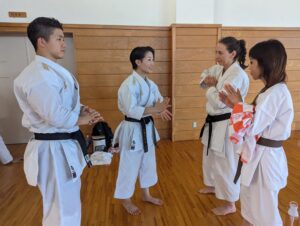
World champions: Kakeru Nishiyama and his wife Hikaru Ohno with Alexandra Alan and Shiho Williams from SKSV at the Seiwakai Japan gasshuku
The soreness, pain and swelling – Dealing with Physical Challenges During Training. When participating in a Gasshuku or intensive training camp, it’s crucial to be prepared for the physical demands and potential discomfort that can arise from rigorous training. Here are some tips for managing soreness, pain, and swelling:
- Accepting the Challenge: Understand that training is meant to push you physically and mentally. Embrace the challenge as an integral part of martial arts and Budo.
- Preventive Measures: Consider bringing items like massage guns, over-the-counter pain relievers (acetaminophen, NSAIDs), and any personal aids you may require, such as knee wraps or braces. These can help alleviate discomfort.
- On-Site Purchases: You can also purchase items locally, including compression wraps, ice packs, and topical pain relief products like Salonpas.
- Know Your Body: Pay attention to your body’s signals and limitations. If you experience pain or discomfort, address it promptly to prevent further injury.
- RICE Method: Familiarize yourself with the RICE method—Rest, Ice, Compression, and Elevation. This self-care technique can be effective for managing pain, reducing swelling, and promoting healing after an injury.
- Rest: Allow your body time to recover between training sessions. Rest is essential for muscle repair and growth.
- Ice: Applying ice to sore or swollen areas can help reduce inflammation and numb pain. Use ice packs or cold packs for short intervals, typically 15-20 minutes at a time.
- Compression: If you have compression wraps or bandages, use them to support injured or sore joints. Proper compression can help reduce swelling.
- Elevation: Elevating the affected area, such as propping up your leg or arm, can aid in reducing swelling.
- Hydration and Nutrition: Stay well-hydrated and maintain a balanced diet to support your body’s recovery and energy levels.
- Consult a Professional: If you experience severe pain or suspect an injury, seek medical attention promptly. Don’t push through serious injuries, as they may worsen.
Remember that training is an opportunity for growth and development, both physically and mentally. By taking proactive measures to manage discomfort and prioritize self-care, you can make the most of your training experience and ensure a safe and fulfilling journey in martial arts.
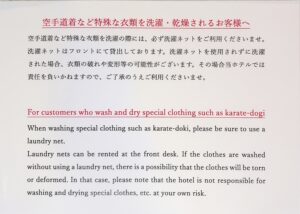
Laundry room sign for gaijin karateka
Managing Your Laundry During Your Stay. In Japan, where living spaces are often compact, many people rely on public laundry facilities for their washing needs. When staying in hotels, you’ll typically find laundry options available, but there are some essential things to keep in mind:
- Public Laundry Facilities: Japan has public laundry facilities in most neighborhoods, and hotels often provide access to them for their guests’ convenience.
- Multiple Karate Do-gi: It’s advisable to bring at least two karate uniforms (do-gi) for your training. This way, you can rotate them, ensuring you always have a dry one available. If needed, you can also use the hotel’s laundry facilities to wash and dry your do-gi.
- Laundry Fees: Be prepared to pay a reasonable fee for using the washing and drying machines. These fees may vary depending on the hotel or public facility.
- Instructions in Japanese: Keep in mind that the instructions on the washing machines and dryers may be in Japanese. If you’re not proficient in the language, consider seeking assistance from hotel staff or fellow travelers. About 50% of machines in Japan automatically add laundry detergent, so pay attention to this feature.
By planning ahead and understanding how laundry works in Japan, you can ensure that your karate uniforms are always clean and ready for training, allowing you to focus on your martial arts practice without any worries.
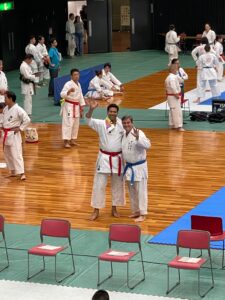
Johnpaul Williams (USA) and Rod Martin (Australia) didn’t win but still they smile!
Set Realistic Expectations forThe Competition you’re not going to win: Be prepared for success in gaining a lifetime experience. Don’t be prepared for ultimate competitive glory!
When participating in a karate competition in Japan, it’s essential to approach it with realistic expectations. While we all strive for success, it’s crucial to remember that the primary goal is to gain a valuable and unique life experience rather than focusing solely on winning. Repeatedly, players have entered shiai (competition) and have left with their dreams no longer intact. Here are some points to consider:
- Focus on the Experience: Instead of fixating on winning, channel your energy into savoring the experience itself. Competing in Japan provides a remarkable opportunity to test your skills against different opponents and styles.
- Self-Awareness: Recognize your own competitive readiness and skill level. It can be challenging to gauge your abilities in a foreign environment, so try to maintain a realistic assessment of your strengths and weaknesses.
- Mental Preparation: Prior to the competition, invest time in mentally preparing yourself. Focus on relaxation techniques and maintaining a positive mindset. It’s essential not only for your performance but also for supporting those in your circle.
- Problem Solving: Be ready to adapt and resolve any challenges that may arise during the competition. Flexibility and quick thinking can help you navigate unexpected situations.
By embracing the experience and setting realistic expectations, you can ensure that your participation in the competition is fulfilling and enriching, regardless of the outcome. Remember, it’s about the journey, personal growth, and the memories you create along the way.
Reflecting on the Journey Home
As you embark on your journey back home from your karate experience in Japan, it’s essential to reflect on the entire adventure in a positive light. Here are some suggestions to help you maintain a constructive perspective:
- Focus on Positives: Instead of dwelling on any negatives, make an effort to identify the blessings and valuable lessons you’ve gained from this unique experience. Take some time to write down your thoughts and reflections.
- Personal Growth: Consider the personal growth you’ve achieved during your time in Japan. Reflect on how this experience has helped you develop as a martial artist and an individual.
- Identify Improvements: Think about areas where you can make improvements, both in your karate practice and in your daily life. Use this as an opportunity for self-improvement.
- Helpful Moments: Take note of the moments that were particularly helpful to you during your journey. These can be valuable insights to share with others in your karate community back home.
By maintaining a positive mindset and focusing on the lessons learned, you can ensure that your return from Japan is filled with gratitude and a sense of accomplishment. This journey is not just about the destination; it’s about the transformation and growth you experience along the way.
Conclusion – Misery loves company so ‘Gaman 我慢’ (suck it up): It is true – Misery loves company and now having 30 or so martial arts training trips to Japan, some 20 of those for Seiwakai combined with the JKF Gōjūkai, I’ll be back for more. Again, this isn’t targeted to any individual and is broadly speaking to every participant regardless of their grade, position, or status. Your journey to Japan for a summer budo Gasshuku is an incredible opportunity for growth and learning. By mentally and physically preparing yourself, embracing humility, and maintaining a respectful attitude, you’ll make the most of this transformative experience. Remember that you’re not just training in Japan; you’re immersing yourself in a rich martial arts tradition and culture. Embrace the challenges, cherish the moments of growth, and return home with a deeper understanding of your art and yourself. Good luck with your training and please enjoy your “not a vacation” expedition to Japan.
Enjoy the trip and cherish your journey,

